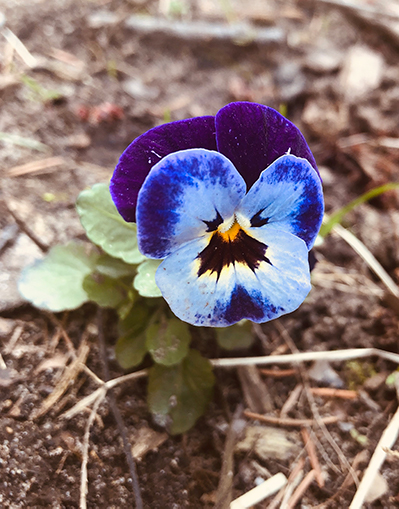
Looking out the window in March when the snow is still flying, or trying to determine in April when the ground is dry enough to dig, we may feel as though spring will never come. Even so, there are many gardening chores that can be done. This is the perfect time to tackle some of the less-than-glamorous but critical tasks that will ensure a splendid garden throughout the year. On days too messy to work outside, there are plenty of jobs for the indoor gardener.
Inspect your tools and remove any rust you find. Sharpen the edges on your cutting tools to make sure you will obtain clean cuts on shrubs and trees. Take your power equipment to get an annual servicing—this includes tillers and lawn mowers. Even though they may not be needed until later in the season, now is a good time to do in, in order to avoid possible long service waits. You can also spend this time to cleaning pots and other containers to be sure that no diseases or pests carry over into the new growing season. Soap and water and/or a bleach or vinegar solution should suffice.
Now is also the time to start seeds indoors. Resources to find the correct time to start seeds and to transplant can be found at monroe.cce.cornell.edu (Gardening Factsheets) and at almanac.com/gardening/plantingcalendar/. Cool season vegetables such as beets, cabbage, leeks, and spinach can be sown or planted outdoors in April or as soon as the ground is workable.
Containers of plants that tolerate cooler temperatures can be placed outside in a sunny location in mid-April. Plants that work well for these early container gardens include pansies, cineraria, oxalis, heuchera, and parsley. Seeing these blooms has the added advantage of chasing away the winter doldrums. The container may need to be covered if a hard freeze is expected.
As the weather improves or on warm winter days you can begin your outdoor preparations such as pruning trees and shrubs and cleaning and readying garden areas. With the leaves still off deciduous trees and shrubs, it’s the perfect time to survey them for broken or diseased branches. You can remove them along with any branches that cross each other. Prune shrubs that need to be shaped. Shrubs that bloom on new wood, like roses, can be pruned back in early spring. Shrubs that bloom on old wood should wait until shortly after blooming. Azaleas fall into this category. There’s a helpful resource for pruning at pubs.ext.vt.edu.
It is also a great time to clear garden beds of leaves and other debris that has accumulated over the winter. Herbaceous perennials that were left to add winter interest to the garden, such as sedum and decorative grasses, should now be cut down close to the ground to allow for new growth. Evergreen and semievergreen perennials like heuchera and lavender can be trimmed of old leaves to improve shape and bloom. Mulching, however, should wait until the ground has warmed up in late May. And, yes, start attacking weeds as soon as they appear.
Once the ground is workable (a handful of dirt is crumbly), garden beds can be prepared for planting. Most plants need well-drained soil. Dense soil can be improved by adding organic matter to help hold moisture and nutrients. A soil test is beneficial to determine if additional nutrients are needed. Some local Cornell Extension offices, like Monroe County’s, can perform soil testing at a reasonable price.
Use of fertilizers should be judicious to avoid runoff harming the watershed. Organic fertilizers are often easier on the environment. Your local nursery should be able to provide advice on which fertilizer to use as well as organic controls for pests, diseases, and weeds.
Lawn rejuvenation should wait until May when the ground is warm enough to germinate seed. The lawn can be prepared now by gently raking up leaves and debris. Vigorous raking at this time may pull up the grass you want, so be gentle. Fertilization of lawns should be delayed until the grass has been mowed a couple of times. Lawn care information is also available on the monroe.cce.cornell.edu website in the Gardening Factsheets.
Start planning for next spring by taking a survey of your garden. Do you have any early signs of spring such as snowdrops, hellebore, witch hazel, flowering quince? What about ephemerals that appear in spring and then die back until the next spring, e.g., bloodroot, Virginia bluebells, hepatica, spring beauty, Dutchman’s breeches, and bleeding hearts? Plant some of these this year and you will be pleasantly surprised early next year when they appear to let you know that spring is coming!
The mantra for all gardeners should be “Right plant, Right place.” Take this time to get fully acquainted with the sunlight and moisture available in different parts of your yard. We all want to rush out and buy something that looks good in the nursery, but will it survive in your garden? Our growing area for perennials, trees, and shrubs is zone 6 near Lakes Erie and Ontario and zone 5 the towards the Southern Tier. Be sure to check the hardiness zone on plant tags.
Finally, both gardening and spring awaken our senses to what is different and emerging around us. By interacting with nature, we learn to appreciate what is possible and needed to make our gardens a joy to behold. We get exercise, learn to solve problems, and make decisions for the benefit our environment. Most importantly, we get to enjoy a sense of peace as we look at the natural beauty we have in our gardens.
—Bonnie Knoke, Master Gardener, Cornell Cooperative Extension, Monroe County
Views: 1




